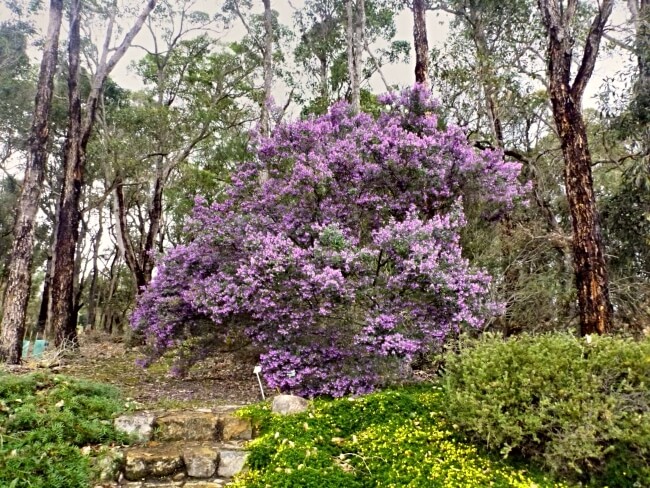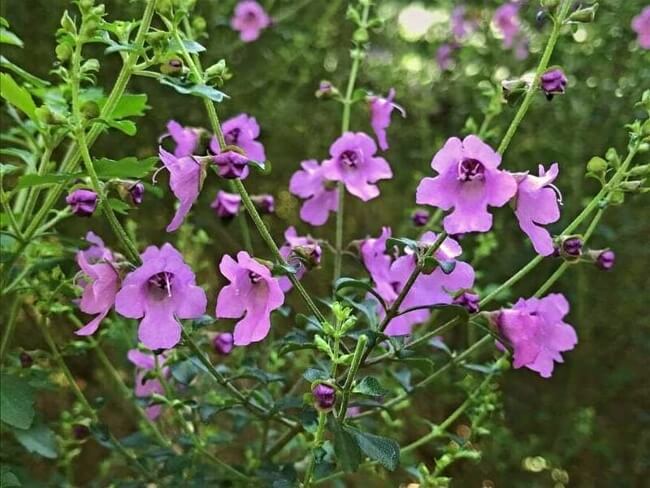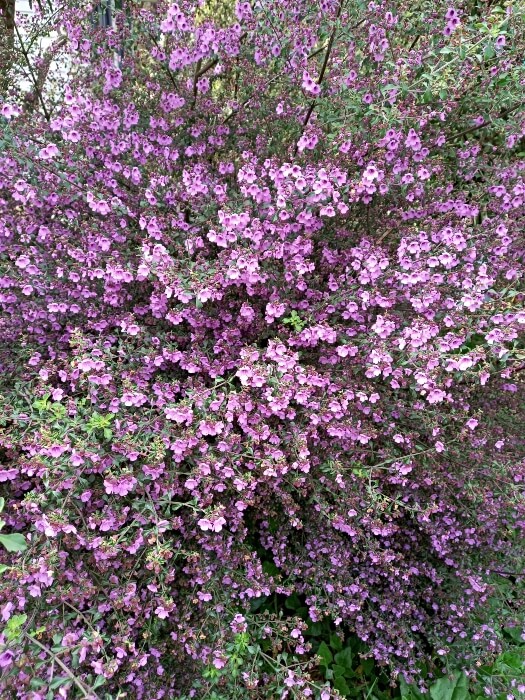Prostanthera incisa is commonly named as the cut-leaf mint bush, referring to its slightly scalloped to pointed leaf edges. This overlooked but beautifully ornamental shrub is considered to be our own native Australian thyme.
With a powerfully enticing aroma likened to rosemary, lemon, mint and that moreish peppery scent bringing it all together, native thyme is a ‘bouquet garni’ of all your favourite herbs in one plant. It has historically, and remains, an iconic part of bush tucker planting but is so underused ornamentally in our gardens.
If you’d like to learn how to grow this incredibly versatile perennial herb, then you’re in the right place. This guide looks at how to plant, care for, propagate and even store native thyme, so you can add your own bush tucker bush to your borders.
More...

Source: Bush to Bowl
Family: | Lamiaceae |
|---|---|
Genus: | Prostanthera |
Species: | P. incisa |
Common names: | Cut-leaf mint bush, Native thyme, Native mint bush |
Origin: | Southeastern Australia |
Location: | Outdoor |
Type: | Shrub |
Growth: | 2m tall and wide |
Sun requirements: | Full sun or part shade |
Foliage colour: | Green |
Flower colour: | Pink or white |
Flowering: | Early summer |
Edible parts: | Leaves are used to make herbal tea, edible flowers |
Maintenance level: | Low |
Poisonous for pets: | Pet safe |
What is Prostanthera incisa?
Native thyme is a highly ornamental shrub with an openly branching habit that stands strong and erect. Its branches are dense and hairy with egg-shaped and slightly oval leaves edged with specific incisions and rounded tips that make the cut-leaf mint bush identifiable from the wider genus.
Prostanthera is a genus housing around 100 species of flowering plants in the mint family. Prostanthera only occurs in Australia and all species are generally referred to as some kind of mint bush due to their aromatic foliage. It has the typical square stem and opposite leaf pattern that all mints have in the Lamiaceae family.
Prostanthera incisa flowers are such a bonus. In spring, you’re rewarded with a burst of mauve flowers similar in shape to a short and stubby snapdragon or penstemon, and they are surprisingly impactful.
What is Native Thyme’s Natural Habitat?
Found naturalising along the coastline of New South Wales around rainforest margins and sclerophyll forest. Prostanthera incisa is specifically found in southeastern Australia whilst other Prostanthera are endemic to all Australian states.
This diverse genus is adaptable and resilient and new hybrids and variations are still being discovered. Prostanthera is a vigorous self-seeder, fast to grow and get established. This is the key to its presence across Australia, inhabiting cooler climates and frosty areas, even as immature plants.
Common Uses for Native Thyme
You wouldn’t have a complete native bush Tucker garden without the native thyme. Although if you’re looking for a specific thyme flavour, technically native thyme doesn’t really taste much like it.
Every part of Prostanthera incisa that grows above ground is edible and has been used for medicinal and edible purposes since aboriginal Australians discovered its potential. It is easy to imagine this herb being used in indigenous times as you get bang for your buck.
The powerful flavour helped make poor cuts of meat palatable and can flavour everything including soups, stews and even biscuits. There are some great archival recipes of it being used in damper bread too, as a little went a long way.
Cut-leaf mint flowers are used to decorate dishes and are also edible.
Another great edible use is to make your own herb butter. Use just a little of your native thyme chopped and mixed with a softened butter. Left to set in the fridge, it’s a lovely way to add flavour to sandwiches and the butter just softens and balances that intense flavour.


Get Your Free Guide:
Master Growing Australian Natives eBook
A Must Have Complete Guide for Every Australian Garden
Get Your Free Guide:
Master Growing Australian Natives eBook
A Must Have Complete Guide for Every Australian Garden
As an apothecary staple, it is very much still in use today, it is often seen being consumed as a herbal tea or tisane.
All Prostanthera produce high yields of essential oil after being distilled, this oil was used medicinally to treat coughs and colds as a steam inhalation. The oil is an antiseptic and antifungal and was also used as an antibiotic for indigenous people.
The scent was known to be able to clear the mind of stress and anxiety through its powerful intoxicating properties too.
How to Grow Native Thyme
Growing native thyme is incredibly rewarding, both in terms of garden design, and garden produce, but where, and how it is planted will define how it responds and develops.
Learning how to prune with harsh confidence, and propagate with a heavy hand is counterintuitive for many gardeners, but in this guide to growing native thyme, we’ll share how and why that is important.

Source: Domus Nursery
Ideal Conditions for Growing Native Mint Bush
Soil & Drainage
Slightly acidic soil will keep native thyme thriving. Prostanthera incisa needs good drainage too, as any waterlogged conditions can cause root rot. In their natural habitat, they would have that forest floor soil, rich in leaf litter and fairly free draining, so mimicking this will help your mint bush to get established.
Light & Temperature
The best light conditions are dappled light but it will also grow in full sun and light shade as long as it has warmth. (Tip: plant it against a nearby wall to offer shelter and heat).
Prostanthera prefers low light but warmth will bring out the oils in the plant, so if you’re looking to encourage scent rather than height, maybe place your native mint bush somewhere it will get passing sunshine.
Shelter
Prostanthera incisa prefers a sheltered position, as can be seen when it naturalises in wet forests under the canopy of eucalyptus trees. But, it is tough and will withstand strong winds when planted in borders. In pots, where its upright stems are more exposed, shelter is advised.
Planting Native Thyme
Native thyme is resilient to any planting conditions and would be suited to rockeries, borders, container growing and even placed in that tricky position under an established tree.
As we’ll explore in the propagation section below, it will recover from nearly all planting methods, be that after division, or by pushing tiny sections of rooted material into gravel.
How to Propagate Cut Leaf Mint Bush
Like all mints, native thyme is desperate to grow and reproduce. It can do that by rotting from stems that are in contact with the ground, by seed, cuttings, or divisions of plants of any age.
Provided the young plants or seeds aren’t sat in boggy conditions, you can grow native thyme from existing stock very simply.
Native Thyme Propagation from Seeds
Prostanthera incisa is a vigorous self-seeder. If you have a specimen to collect seed from all the better, if not, seed can be purchased from specialist nurseries and most online native seed suppliers.
- Sow seeds thinly on the surface of some peat-free compost.
- Do not cover as they need light to germinate.
- Water through the bottom of the tray if possible (this will ensure the seeds bed in well)
- Leave them somewhere bright and well-ventilated but out of full sun.
- Germination takes about a week in spring or summer.
Propagating Native Thyme from Cuttings
Propagation from cuttings is simple and reliable, this can be done in autumn or spring.
- Snip off a non-flowering tip of fresh growth. Something that has several leaf nodes would be perfect cutting material.
- Strip of all but the top leaves.
- Insert the cutting in a pot filled with peat-free compost and preferably some added drainage like grit or vermiculite.
- Dib your cutting down the edge of the pot, this will give it some stability and also encourage it to strike as the pot warms up in the sun. Push the stem as deep as possible, as each node will send new roots out.
- Mist and water regularly. Cover with a cloche or plastic bag to increase chances of rooting.
- Rooting usually takes a week to start, and a month until roots are visible around the edge of the pot.
Note: Mature shrubs will nearly always have small plants growing alongside them. These have come up from the roots and can be dug out with a trowel. Either plant them directly where they are to grow or pop them into small pots until they have a space.
How to Care for Native Thyme
Prostanthera generally doesn’t require much maintenance. However, regular harvests of the leaves will help maintain a good shape and fresh new growth.

Source: Wildtech Plants
Pruning Native Thyme
If not pruned, it can become very leggy and sprawling over some years. Native thyme tends to be fairly short-lived generally, so by pruning regularly you are keeping your plant as healthy as possible.
Essentially, the tighter it’s clipped, the longer it lives. This is down to encouraging fresh growth, while also limiting top-heavy branches that dry out and demand more of the roots.
Repotting Native Thyme
Growing native thyme in pots is a great way to give it the exact requirements it needs. However, it’s important to keep it well watered, especially in periods of prolonged dry weather.
Occasionally repotting (every 3-4 years) will provide native thyme with fresh, slightly acidic compost and encourage new, fresh growth which can be harvested at will. It also provides an opportunity to divide any young suckering plants that are growing alongside their parent plant.
Native Thyme Bush Tucker Guide
Harvesting Native Thyme
As it’s so fast-growing, native thyme can be harvested just a short while after growing from seed. To harvest cut-leaf mint bush, simply pluck individual leaves off or prune larger whole stems off depending on the amounts needed. Leaves, stems and flowers can all be used.
How to Store Native Thyme
Prostanthera incisa can be dried whole or chopped. Whole stems and bunches can be dried by hanging them upside down in a cool and dry place. Once fully dried, store in an airtight container to keep humidity out.
Tip: To check if they are ready for storage, bend a stem from a drying bunch. If it snaps with a crisp crack, it's dry and all moisture has left the plant.
Common Native Thyme Pests and Diseases
This resilient shrub isn’t typically troubled by any pests, you may occasionally find some damage from caterpillars or slugs, but it shouldn’t be of detriment to the plant's overall health.
Underwatering is easily apparent as the foliage of your native thyme will droop. If the soil is dry, water it well, and it should start to recover in around 24 hours. If that doesn’t work, it may benefit from cutting back to the lowest new growth.
It is essential to check the soil's health before assuming it is dry or under water. This is because root rot, caused by overwatering, can cause nearly identical symptoms.
Prostanthera incisa wants to be moist, but without being waterlogged. If it’s left in damp conditions it may start to develop yellowing leaves. This is a sign that your native thyme may have developed root rot.
Native Mint Bush Frequently Asked Questions

Source: Peppermint Ridge Farm
How big does Prostanthera incisa get?
Prostanthera incisa can reach 2m tall, making it a surprisingly useful edible hedge plant. However, when it gets to that height it is often quite leggy, so should be pinched out regularly while it develops to create a denser form.
How do you take care of a Prostanthera incisa?
Because Prostanthera incisa can be grown in such a wide variety of ways, it's impossible to give one simple rule for caring for it. But, in nearly all cases, pruning back to a healthy pair of leaves after flowering will encourage a bushier, happier shape.
How do you use native thyme?
Native thyme can be used fresh, dried, or steeping in water. It is most useful as a medicinal herb when taken whole, but brewing fresh leaves in hot water is the easiest way to use the leaves and stems.
What are the health benefits of native thyme?
The health benefits of native thyme include antiseptic and antifungal applications, but perhaps its most common modern use is as a mood supplement, taken by inhaling steam from the steeped leaves or crushing the leaves for a fresh fragrance - both methods are widely recommended as sensory treatments for general anxiety.
How do you prune a Prostanthera incisa?
Prostanthera incisa pruning can take many forms, but pinching stems back after flowering is the best way to get a natural shape without it becoming leggy. It's also worth noting that it can be cut back hard in mid to late winter, encouraging fresh growth in spring.
Will potted native mint bush come back?
Native mint will come back year after year, whether it is potted or planted in the ground. It prefers to remain dry over winter, and despite being evergreen it will usually have a brief dormant period, so potted plants can either be left in situ or moved into a greenhouse to protect from wet weather.
Can I leave native thyme outside in the winter?
Native thyme is frost-hardy and will cope with winter conditions in the ground. Young plants should be protected from frost, but mature plants require no special winter treatment.
Bring Local Charm and Culinary Delight to Your Garden with Native Thyme
Prostanthera incisa is a bush tucker bonanza. It’s versatile and resilient, and on top of that, it’s actually beautiful. Native thyme flowers attract many pollinators and are perfect for foraging bees - their flower shape is highly attractive to native bees. Because it forms quite a dense shrub it is also a brilliant habitat for ground-nesting critters and attracts a whole host of native wildlife when used as hedging.
This wonderful evergreen native thyme will give you interest all year round and is a perfect addition to a sensory garden with its powerful fragrance and delicate masses of purplish flowers.
Published on March 27, 2024 by Gary Clarke
Last Updated on January 27, 2025




